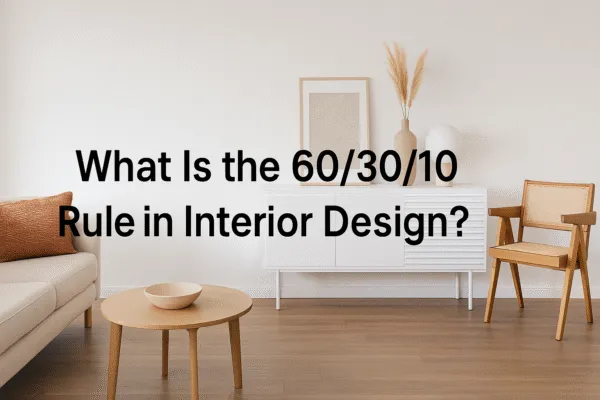
What Is the 60/30/10 Rule in Interior Design?
Introduction
Interior design thrives on principles that balance beauty, functionality, and comfort. Among these principles, the 60/30/10 rule is one of the most practical and timeless. This simple formula helps designers create cohesive and visually appealing spaces by defining how colors should be distributed in a room.
For homeowners and businesses in Palm Desert, CA, working with the best interior designer in Palm Desert ensures that this rule is not just applied in theory but tailored to your unique lifestyle, climate, and aesthetic preferences. In this article, we’ll explore what the 60/30/10 rule is, why it works, and how it transforms ordinary interiors into extraordinary spaces.
Understanding the 60/30/10 Rule
The 60/30/10 rule is a guideline for color distribution in a space:
60% (Dominant Color): The primary shade used in a room, often on walls, large furniture, or flooring.
30% (Secondary Color): The contrasting color that adds depth, often used on upholstery, curtains, or accent walls.
10% (Accent Color): A bold or vibrant tone used sparingly to create visual interest, often through accessories, artwork, or decorative items.
This balance creates harmony, ensuring that no single color overwhelms the space while still allowing room for creativity.
Why the 60/30/10 Rule Works
Psychological Balance: Humans naturally find spaces with proportioned colors more comfortable.
Visual Hierarchy: The dominant color grounds the design, the secondary color adds variety, and the accent injects personality.
Timelessness: Whether you prefer modern minimalism or traditional elegance, this formula adapts to any style.
An experienced best interior designer in Palm Desert knows how to apply this rule while also considering lighting, texture, and the unique desert environment.
Applying the Rule in Palm Desert Homes
Palm Desert has its own design identity influenced by desert landscapes, luxury lifestyles, and modern architecture. Here’s how the 60/30/10 rule often plays out:
60%: Neutral desert-inspired tones like sand, beige, or soft gray.
30%: Warm secondary shades such as terracotta, olive green, or muted blues.
10%: Bold accents like metallics, vibrant orange, or deep teal.
This combination creates spaces that feel connected to the desert surroundings yet modern and luxurious inside.
Examples of the 60/30/10 Rule
Living Room
60%: Light beige walls and large sectional sofa.
30%: Deep green armchairs and curtains.
10%: Gold side tables, patterned throw pillows, and artwork.
Bedroom
60%: Soft gray bedding and walls.
30%: Navy blue upholstered headboard and curtains.
10%: Burnt orange pillows and metallic lamps.
Office Space
60%: White walls and flooring.
30%: Wood tones in desks and shelving.
10%: Black desk accessories and artwork.
Benefits of Using the 60/30/10 Rule
Creates Cohesion: Ensures rooms feel balanced and intentional.
Simplifies Choices: Narrowing down colors avoids overwhelm.
Adds Personality: Accent colors reflect individuality.
Works Everywhere: From small apartments to luxury Palm Desert estates.
Common Mistakes to Avoid
Too Many Accent Colors: Stick to one or two to avoid chaos.
Ignoring Textures: Different finishes add dimension to the same color.
Overpowering Secondary Colors: Keep them truly secondary, not dominant.
Forgetting Natural Light: Sunlight in Palm Desert can intensify or fade colors.
Why Work with a Professional Designer?
While anyone can attempt the 60/30/10 rule, professionals take it further by considering:
Proportions of furniture and space.
Cultural or personal influences in color selection.
Lighting (both natural desert light and artificial fixtures).
Long-term durability of color schemes.
Hiring the best interior designer in Palm Desert ensures that these nuances are respected, resulting in a design that is stylish, functional, and personalized.
Conclusion
The 60/30/10 rule is a golden formula in interior design that simplifies color selection while creating balance and harmony. By using 60% dominant color, 30% secondary color, and 10% accent color, designers can transform spaces into cohesive and stylish environments.
For Palm Desert homeowners and businesses, the best interior designer in Palm Desert brings this principle to life while adapting it to desert-inspired aesthetics and modern luxury living.
10 Frequently Asked Questions (FAQs)
1. What does the 60/30/10 rule mean in interior design?
It’s a guideline for distributing colors: 60% dominant, 30% secondary, 10% accent.
2. Why is this rule effective?
It creates harmony and prevents any one color from overwhelming the room.
3. Can the rule be applied to small spaces?
Yes, it works especially well in smaller areas by maintaining visual balance.
4. Do I have to follow it strictly?
No, it’s a guideline—professional designers sometimes adjust proportions.
5. What colors work best in Palm Desert homes?
Neutral desert tones with warm secondary colors and bold accents.
6. How do accent colors change a room?
They add personality, vibrancy, and focal points.
7. Can textures be part of the 60/30/10 rule?
Yes, textures and finishes can count as part of your color scheme.
8. Do designers always use three colors?
Most designs stick to three, but professionals may expand creatively.
9. Can this rule work with monochromatic schemes?
Yes, variations in lightness and texture can fulfill the proportions.
10. Why hire the best interior designer in Palm Desert for this?
Because they tailor the rule to your home, ensuring style, balance, and functionality.



